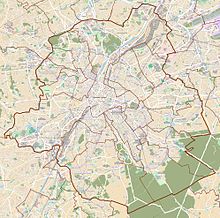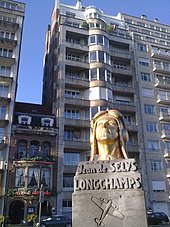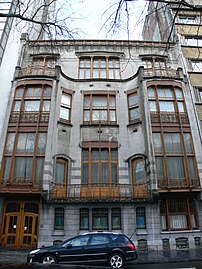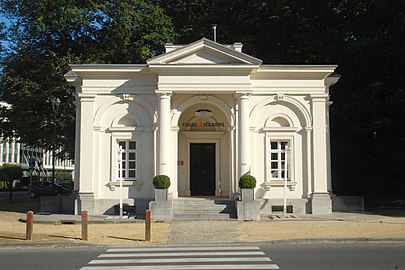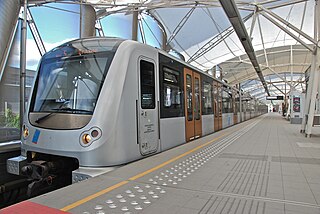
The Brussels Metro is a rapid transit system serving a large part of the Brussels-Capital Region of Belgium. It consists of four conventional metro lines and three premetro lines. The metro-grade lines are M1, M2, M5, and M6 with some shared sections, covering a total of 39.9 kilometres (24.8 mi), with 59 metro-only stations. The premetro network consists of three tram lines that partly travel over underground sections that were intended to be eventually converted into metro lines. Underground stations in the premetro network use the same design as metro stations. A few short underground tramway sections exist, so there is a total of 52.0 kilometres (32.3 mi) of underground metro and tram network. There are a total of 69 metro and premetro stations as of 2011.

The City of Brussels is the largest municipality and historical centre of the Brussels-Capital Region, as well as the capital of the Flemish Region and Belgium. The City of Brussels is also the administrative centre of the European Union, as it hosts a number of principal EU institutions in its European Quarter.

Saint-Gilles or Sint-Gillis is one of the 19 municipalities of the Brussels-Capital Region, Belgium. Located in the southern part of the region, it is bordered by the City of Brussels, Anderlecht, Forest and Ixelles. In common with all of Brussels' municipalities, it is legally bilingual (French–Dutch), but predominantly French-speaking nowadays.

The Bois de la Cambre or Ter Kamerenbos (Dutch) is an urban public park in Brussels, Belgium. It lies in the south of the Brussels-Capital Region, in the City of Brussels, and covers an area of 1.23 km2 (0.47 sq mi), forming a natural offshoot of the Sonian Forest, which penetrates deep into the city in the south-east of Brussels. It is linked to the rest of the municipality by the Avenue Louise/Louizalaan, which was built in 1861, at the same time the park was laid out.

Ixelles or Elsene is one of the 19 municipalities of the Brussels-Capital Region, Belgium. Located to the south-east of Brussels' city centre, it is geographically bisected by the City of Brussels. It is also bordered by the municipalities of Auderghem, Etterbeek, Forest, Uccle, Saint-Gilles and Watermael-Boitsfort.

The Brussels tramway network is a tram system serving a large part of the Brussels-Capital Region of Belgium. It is the 16th largest tram system in the world by route length, in 2017 providing 149.1 million journeys over routes 140.6 km (87.4 mi) in length. In 2018, it consisted of 18 tram lines. Brussels trams are operated by STIB/MIVB, the local public transport company.

La Cambre Abbey or Ter Kameren Abbey is a former Cistercian abbey in the City of Brussels, Belgium. It is located in the Maelbeek valley between the Bois de la Cambre/Ter Kamerenbos and the Ixelles Ponds. The abbey church is a Catholic parish of the Archdiocese of Mechelen–Brussels and home to a community of Norbertine canons, while other parts of the monastery house the headquarters of the Belgian National Geographic Institute (NGI) and La Cambre, a prestigious visual arts school.
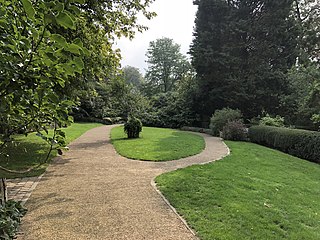
Tenbosch Park, Tenbosch or Tenbos, is a public park in the municipality of Ixelles in Brussels, Belgium. Although relatively small with an area of 2 ha, it is a landscaped park popular among local residents. It is surrounded by a wall and offers an unexpected oasis of calm in a busy district.

The Ixelles Ponds or Elsene Ponds are two freshwater ponds in the Brussels municipality of Ixelles, Belgium. The ponds we can see today are those spared by a 19th-century campaign of drying the wetlands of the Maelbeek valley between La Cambre Abbey and the Place Eugène Flagey/Eugène Flageyplein.

The Fortifications of Brussels refers to the medieval city walls that surrounded Brussels, Belgium, built primarily to defend the city but also for administrative reasons. There were two stages of fortifications of Brussels: the first walls, built in the early 13th century, and the second walls, built in the late 14th century and later upgraded. In the 19th century, the second walls were torn down and replaced with the Small Ring, a series of boulevards bounding the historical city centre. Nowadays, only a few sections of each walls remain, most notably the Halle Gate.

Baron Jean Michel P.M.G. de Selys Longchamps DFC was a Belgian aristocrat and RAF fighter pilot during World War II. He is chiefly known for his single-handed attack on the Gestapo headquarters in Brussels in German-occupied Belgium.
The Greater Ring or Intermediate Ring in Brussels, Belgium is a set of roads in the shape of a ring, intermediate between the Small Ring and the main Brussels Ring motorway. The greater part of this set of roads is numbered R21 and is about 30 km long, compared to 8 km for the Small Ring and 80 km for the main Ring.
The Brussels tram route 23 was a Brussels tram route operated by STIB/MIVB in Brussels, Belgium. It ran between Vanderkindere, which was also the terminus for tram route 24 and where passengers could commute with tram routes 3, 4 and 92, and the Heysel/Heizel metro station, which offers transit with the Brussels metro line 6, tram route 51 and bus routes 84 and 88. Since March 14, 2011 the newly formed tram 7 follows the same route as tram 23, but with a much higher frequency. Because of the frequency being brought up to 'metro' level, its line number was altered to the lower regions, for those are the metro and so-called 'Chrono' tramlines. Tram 24 was also taken over completely by the newly formed tram 7.

Tram route 81 in Brussels, Belgium, is a tram route operated by STIB/MIVB, which connects the Marius Renard stop in the municipality of Anderlecht with the multimodal Montgomery metro station in Woluwe-Saint-Pierre. The route also crosses the municipalities of Saint-Gilles, Ixelles, the City of Brussels and Etterbeek. It connects with the Metro at Saint-Guidon/Sint Guido, Brussels-South, Merode and Montgomery. The route also crosses the major tram routes 3 and 4 at Horta. A good deal of its length is in carriageway, while long sections at either end are in reservation. It has a short section in tunnel at Brussels-South.

The Villa Empain is a former private residence in Brussels, Belgium, which currently serves as a cultural centre and exhibition space. Built in 1930–1934 in Art Deco style by the Swiss-Belgian architect Michel Polak, the villa was commissioned by Baron Louis Empain, son of the industrialist Édouard Empain. It subsequently served as offices and an embassy before falling into disuse. After a restoration from 2009 to 2011, it was opened to the public by the Boghossian Foundation.

The following is a timeline of the history of Brussels, Belgium.

The Hotel Brussels is a four-star hotel in the Louise/Louiza district of Brussels, Belgium, owned and managed by the Swedish hotel group Pandox AB. A landmark building, it originally opened as the Brussels Hilton in 1969. Pandox AB purchased the building in September 2010, assumed management in February 2011 and commenced a complete renovation of the 27 floors. The renovations were completed after a two-year period.

The Namur Gate was one of the medieval city gates of the second walls of Brussels, Belgium. Built in the 14th century, it was demolished in 1784 during the construction of the Small Ring.
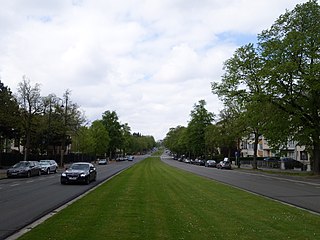
The Avenue Franklin Roosevelt (French) or Franklin Rooseveltlaan (Dutch) is an avenue in Brussels, Belgium. It is located in the southern part of the City of Brussels, near the border with the municipality of Ixelles, where it runs parallel to the Bois de la Cambre/Ter Kamerenbos. It is named in honour of the 32nd President of the United States, Franklin Delano Roosevelt.
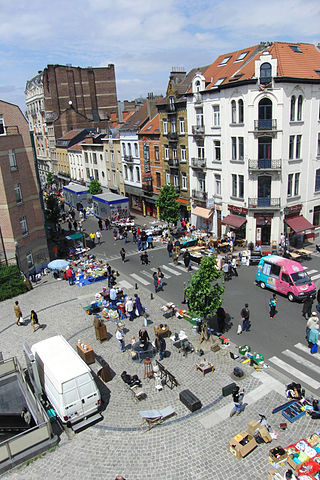
The Chaussée de Waterloo or Waterloosesteenweg (Dutch), is a long north–south arterial road from Brussels to Waterloo, Belgium. It begins at the Halle Gate in the Brussels municipality of Saint-Gilles, continues a course towards the south-east until the Bascule area of Uccle, then turns south in the direction of Waterloo, where it changes its name to become the Chaussée de Bruxelles and continues in the direction of Genappe and Charleroi (Wallonia) until the regional border. Its length is 12.4 kilometres (7.7 mi) and its width between 15 and 18 metres.

